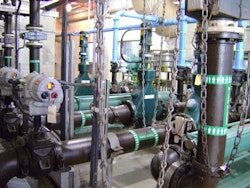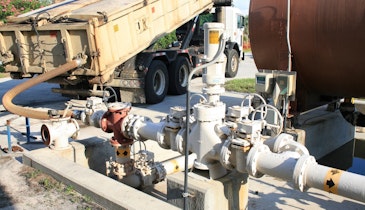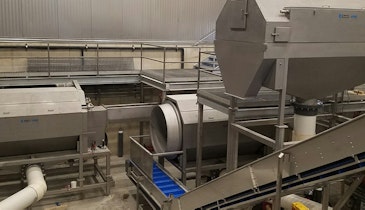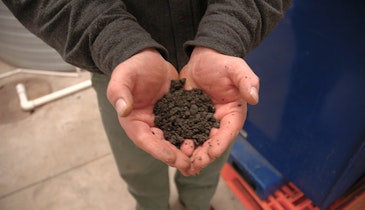
Many municipal anaerobic digesters are operating at less than optimum performance because of built-up sludge, which can limit the effectiveness of the anaerobic digestion system. Poor digester performance not only increases the need for maintenance and repairs, but also makes it difficult to meet stabilization requirements, and can result in high-odor biosolids.
Digester sludge has seen a steady increase of disposable wipes and other nondispersible products. Headworks differ from plant to plant, and many still have legacy, original-equipment bar screens that are inadequate at stopping the greatly increased flow of these nondispersibles, which end up in anaerobic digesters intact. The wipes and plastic clump together with organic debris, forming large rag-balls within the digesters — clogging pumps, valves and pipes, and increasing the need for clean-outs, maintenance and repairs.
Managing digester sludge clean-outs
Anaerobic digesters should be dewatered and the sludge cleaned out approximately every 10 years to maintain best operability, as well as to perform inspection and repairs. But many WWTPs delay sludge clean-outs for up to 20 years, accruing escalating maintenance and repair costs.
Digesters are costly to maintain, and it’s expensive to clean out the sludge. Expenses can exceed $100,000 to dewater and remove the sludge from a large digester, and cleaning can take more than a month to complete. If a plant has several digesters, the cost is even more significant.
This was the scenario with the Regional Treatment Plant (RTP) of the South Orange County Wastewater Authority (SOWMA), in Orange County, California, which was dealing with expenses of $120,000 to remove sludge from each of its four 950,000-gallon anaerobic digesters.
The RTP is a conventional activated sludge treatment facility with a liquid handling capacity of 12 mgd, and an equivalent of 24.6 mgd solids handling capacity. The plant’s wastewater treatment unit operations and processes include screening, grit removal, primary clarification, secondary treatment (activated sludge) and secondary clarification, dissolved air flotation thickening, anaerobic digestion and solids dewatering.
A portion of the secondary effluent receives tertiary treatment by chemical addition, coagulation, filtration and chlorine disinfection. This tertiary treated recycled water is used for landscape irrigation. The current capacity of the tertiary treatment facility is 11.4 mgd. The remaining effluent is discharged to the Pacific Ocean through the Aliso Creek Ocean outfall.
Besides managing its own solids from its treatment process, the RTP also manages solids trucked in from the neighboring plants. Solids treatment consists of dissolved air flotation thickening, anaerobic digestion and centrifuge dewatering.
The RTP collects methane gas from the anaerobic digesters to power its cogeneration facility, which consists of three engines equipped with a heat recovery system and 400 kW generators. The cogeneration system utilizes approximately 75% digester gas and 25% natural gas as fuel during normal operation. Waste heat is circulated to provide hot water to heat the anaerobic digesters. Electrical power is generated by the cogeneration system and used entirely by the wastewater treatment plant. Approximately two-thirds of the treatment plant’s electrical power needs are supplied by the cogeneration facility.
“The RTP plant has been online since 1983, and we did our first digester clean-out about 10 years later in the early 1990s,” says Bob Waters, chief of operations at the RTP. “We were converting the covers on our four 950,000-gallon anaerobic digesters from floating steel covers to fixed covers, and in the process drained the digesters and cleaned out the sludge.”
.jpeg) It was 17 years later, in 2010, when the RTP again undertook cleaning out the sludge from its digesters. “We dewatered the first digester about 50%, to a point where a contractor could gain access through a manway to install a submersible pump,” Waters says. “It cost $120,000 for the remaining 50% of the digester to be dewatered, and then remove the sludge. That was fairly costly for us, and we had three more to do. We thought, there must be a better way.”
It was 17 years later, in 2010, when the RTP again undertook cleaning out the sludge from its digesters. “We dewatered the first digester about 50%, to a point where a contractor could gain access through a manway to install a submersible pump,” Waters says. “It cost $120,000 for the remaining 50% of the digester to be dewatered, and then remove the sludge. That was fairly costly for us, and we had three more to do. We thought, there must be a better way.”
A mechanic at the RTP came up with an idea to use a rotary drum screen to clean the sludge from the remaining three digesters. They contacted a screen representative, who suggested a JWC Environmental Drumscreen Monster, an internally fed rotary drum screen used in industrial high-efficiency wastewater applications.
“We drained the second 950,000-gallon anaerobic digester ourselves, then we put the rotary drum screen to work on the sludge,” Waters says. “The drum has a 1/8-inch wedgewire screen, and uses an internal auger to separate the plastics and other debris from the sludge. We used fire hoses to break up the sludge and slurry it to the pumps that fed the drum. Then we hired a contractor to clean the remaining sludge material that we couldn’t access. The cost for cleaning the sludge from the second digester, including the contractor cost, was $40,000.”
Before starting sludge cleaning on the third anaerobic digester, the RTP made some adjustments, like upgrading from 6-inch pumps to 8-inch pumps, to feed the Drumscreen Monster. They also elevated the drum so that a collection bin could be positioned underneath it to more easily collect the plastics and debris as it was exiting via the auger.
“On the third 950,000-gallon digester, we performed most of the work, from dewatering through sludge removal,” Waters says. “We did use a contractor for some sludge removal, but we were able to get our total costs down to $20,000.”
Prior to the dewatering and sludge removal from the fourth and final 950,000-gallon digester at the SOCWA Regional Treatment Plant, their cleaning process was further improved. Adjustable nozzles were installed to the fire hoses, and hose stands were put into place. This permitted the fire hose nozzles to move vertically and horizontally while maintaining a fixed location. They could then hydroblast the sludge slurry into the Drumscreen Monster.
“With the modifications to the fire hose setup, we could now break up the sludge and slurry it into the drum screen faster,” says Waters. “On this fourth digester we used a contractor just to remove some rag ball material; otherwise, we did the work ourselves. Our total cost for dewatering and sludge removal from this last digester was $10,000.”
Drumscreen Monster
The plant’s JWC Drumscreen Monster is designed for high flows with heavy solids loading — well suited for handling digester sludge applications.
“The design of this drum screen and its slow-speed operation reduces water usage, increases solids and debris discharge dryness, and minimizes blinding,” says Bert Irwin, with JWC Environmental.
“The drum is engineered to deliver the effluent sludge on a tangential. So the water and the solids are never going directly towards the holes. The debris is being directed away from the surface of the drum. This enables it to handle high volumes of debris-laden wastewater without blinding.”
“This screen is a workhorse — it uses very little electricity and requires virtually no maintenance,” Waters adds. “We have now been trucking it around to other SOCWA facilities to clean their digesters too.”
Screening as an in-line process
During the sludge cleaning of the four digesters, the JWC Environmental Drumscreen Monster was positioned outside of the anaerobic digester tanks. But the RTP is now looking at how the rotary screen can be set up as an in-line process, cleaning the digesters while they are online, instead of taking the digesters out of service to clean out the sludge.
“If we can adapt the Drumscreen Monster to clean out the plastic and the rag balls that get inside the digesters, while they are online, then we could most likely delay the full-scale dewatering and cleaning cycles,” Waters says. “This would be a major accomplishment that would improve the uptime running of the digesters. We are working on it.”





